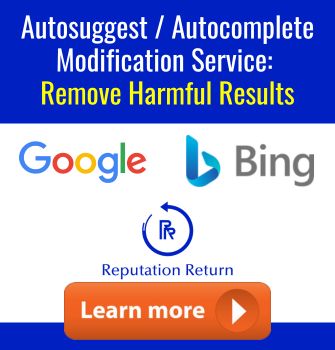This article discusses various brand risks and offers solutions to protect your company’s reputation online.
The term “brand risk” refers to the potential for a brand to either fail completely or lose value in the market. While there are many types of brand risks, most of them can be managed via risk management strategies and brand reputation management. Risk management involves identifying, treating and monitoring brand risks.
To speak with a reputation management expert immediately, give us a call at
(844) 458-6735
today.
The Importance of Your Brand Name

One of the most valuable assets a business has is its brand name.
When you have a strong brand, it’s easier to acquire new customers and retain existing customers. New products or services often have successful launches, and word-of-mouth marketing does a lot of your promotional work for you.
In essence, a strong brand leads to higher returns with lower risk.
On the other hand, poor branding strategies and a lack of risk management can put your company in a dire position. This can negatively impact brand equity, cash flow, revenue and more.
By identifying potential risks early, you can catch problems before they snowball out of control.
7 Brand Risks You Need To Know About


In order to mitigate potential risks, you first need to identify potential risks. Let’s go over the 7 most common brand risks that companies should know about.
1. Brand Awareness Risk
Poor advertising and marketing strategies can lead to a brand awareness issue. In this case, your target audience doesn’t associate your brand with a specific product or service. This means they won’t automatically turn to your company to meet their needs.
2. Brand Recognition Risk
If your company has brand recognition, that means that customers and the public can recognize your brand from its visual elements, like colors, logos, products, and symbols. If you haven’t developed brand recognition or have been unable to stand out from the competition, you may have a brand recognition problem. This is also common following a branding redesign.
3. Lack of Customer Loyalty
Sometimes, companies will lose loyal customers because needs, preferences or trends change. Other times, negative customer experiences can lead to a disloyal customer base. Remember, customer feedback has far-reaching consequences. As others read negative reviews, your company stands to lose more than just one unhappy customer.
4. Poor Brand Legacy
Your brand’s legacy is the history of your company. It may be positive, like a brand with a long track record of giving back to its community or selling high-quality products. Or, it may have led to a negative public opinion, like if your company’s faced PR crises or is known for having terrible customer service.
5. Positioning Issues
Brand positioning refers to the specific position your company takes and if customers remember you for that position. For example, a juice company may position itself as “affordable” and “organic.” But if your target customers don’t know or remember that, either because you failed to position your brand or a competitor has taken over that position, this is a risk.
6. Public Perception Risks
The way the public views your brand is a major factor in your company’s perceived value. Whether or not it’s based on factual information, negative brand perception from the public is a major risk and can seriously harm your company’s reputation.
7. Reputational Risks
Your online brand reputation should reflect your company values. If there’s a gap between how you want to be perceived online and how customers actually perceive your brand online, there’s a problem.
To speak with a brand reputation expert, give us a call at
(844) 458-6735
for a free consultation.
4 Reasons Why It’s Necessary To Identify Potential Brand Risks Early


You can’t always avoid brand risks, no matter how hard you try. The next best option is to identify potential risks as early as possible to prevent them from becoming larger problems that are harder to troubleshoot.
Here are 4 reasons to catch potential risks as soon as you can:
1. Proactive Responses
Detecting a brand risk early gives you the opportunity to take proactive measures. Doing this means minimizing the damage caused to your business finances, public perception and reputation.
2. Maintain Trust
Responding quickly to a negative brand event and minimizing the fallout makes it easier for investors and customers to trust you. The last thing you want during a brand crisis is lose more than you already have.
3. Avoid Legal Trouble
Some brand risks result in legal and regulatory actions, especially if they’re ignored. Addressing a risk early on can put you in a position to fix the problem before it becomes a legal issue.
4. Identify Internal Issues
Once the dust has settled, you can take a deeper look at the problem that occurred. It’s possible you’ll identify internal risks that can be solved now to prevent trouble in the future. Smart business owners know that there are always lessons to be learned, even in failures.
Review management is one of many ways to prevent external risks from hurting your brand. Call us at
(844) 458-6735
today to learn more.
How To Detect Brand Risks


There are several methods for monitoring and detecting brand risks. Let’s go over a few common ones.
Employee and Customer Surveys
Collecting information from employees as well as customers will alert you to problems that continue to arise.
The employees who speak to customers on a regular basis will be able to tell you which issues come up again and again. You can then update your business model to address problems at the root.
Sending out surveys that ask for anonymous customer feedback is another great way to figure out if there’s a positive image of your brand.
News Monitoring
Online listening tools can track mentions of your brand online to catch news coverage, press releases, podcasts and more that discuss your company. Also, by having these tools watch for market-related keywords, you can gain a competitive advantage by staying ahead of trends.
Social Media Monitoring
With social media listening tools, you or your online reputation management (ORM) team can track mentions of your brand, products, and services online. This lets you find out what people are saying and identify potential risks before they go viral.
Social listening can be used in several ways to protect and enhance your brand:
- Keyword and hashtag monitoring to immediately be alerted when your company is mentioned
- Sentiment analysis to assess the tone of comments about your brand
- Identifying influencers to engage and potentially partner with
You can also use social media monitoring to learn about the brand perception of your competitors. By determining the areas where customers are disappointed, you can fill in gaps in the market.
Risk Management Software
Professional brand reputation and risk management companies use high-end software that tracks all sorts of risks in different areas. For example, risk management tools can detect data security issues, financial fraud, and product safety problems.
Professional Help to Protect Your Company’s Reputation
When a brand is at risk, it could quickly lose value, leading to problems that are difficult — and sometimes impossible — to treat.
To recap, the 7 major brand risks to be aware of are:
- Awareness
- Customer loyalty
- Legacy
- Positioning
- Public perception
- Recognition
- Reputation
Nothing is more important than your brand name. Proactive measures improve a company’s ability to bounce back from issues while avoiding legal and regulatory consequences. And for true growth, it’s important to assess what went wrong and make a strategic plan to avoid the same problem in the future.
Our team of experts can help you protect your online reputation, avoid common brand risks, and set you up for long-term success.
Give us a call at
(844) 458-6735
today to discuss risk management strategies.















